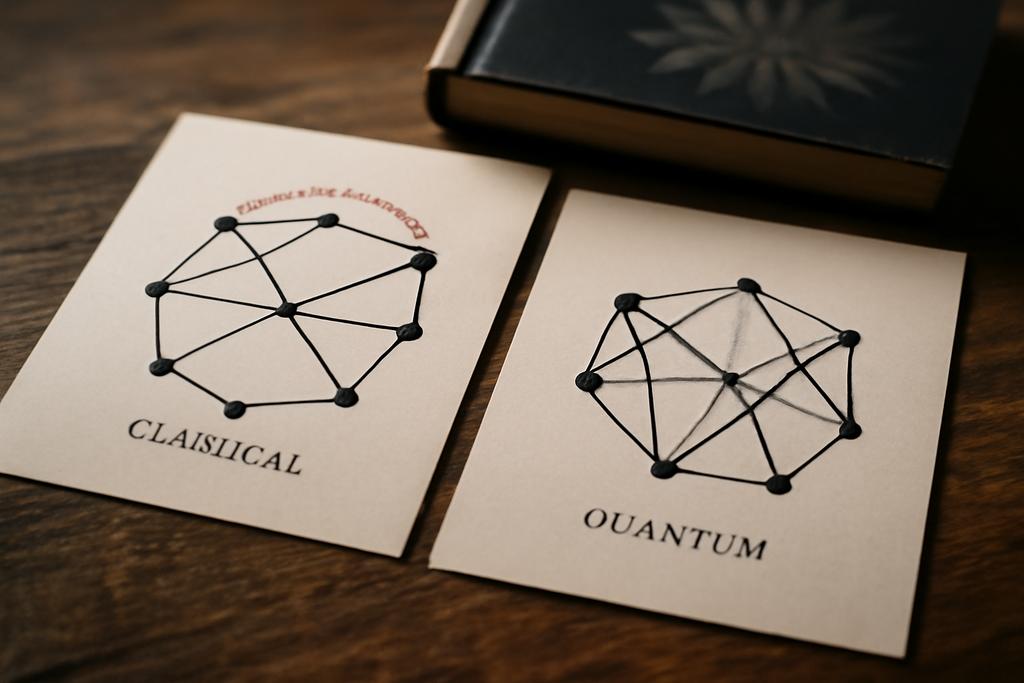Symmetry Beyond the Classical Horizon
Symmetry is a language nature speaks fluently, from the petals of a flower to the orbits of planets. In mathematics, symmetry often reveals itself through automorphisms — transformations that shuffle parts of an object without changing its essence. For graphs, these automorphisms are permutations of vertices preserving connections, the classical symmetries we can visualize and understand.
But what if symmetry could be quantum? What if the rigid notion of swapping vertices gave way to a more fluid, noncommutative dance? This is the realm of quantum automorphism groups, a concept that extends classical symmetry into the quantum world, where the rules of commutation no longer hold and new, richer structures emerge.
Simon Schmidt from Ruhr University Bochum and Makoto Yamashita at the University of Oslo have ventured deep into this quantum wilderness, focusing on a special class of graphs known as 3-transitive graphs. These are graphs so symmetric that any rearrangement of any three vertices can be extended to a symmetry of the whole graph. Their work, recently published, uncovers which of these highly symmetric graphs harbor hidden quantum symmetries and which stubbornly cling to their classical roots.
Why 3-Transitive Graphs? The Perfect Playground
3-transitive graphs are the aristocrats of symmetry in graph theory. Classified by Peter Cameron and H. D. Macpherson in 1985, these graphs include famous examples like the Schläfli and McLaughlin graphs, and a family of polar graphs arising from deep geometric constructions. Their extreme symmetry makes them ideal candidates to explore quantum automorphisms, as classical symmetry often guides the quantum counterpart.
Quantum automorphism groups were introduced in the early 2000s, generalizing classical automorphisms by allowing the permutation matrices to be replaced by more general quantum objects. These quantum groups can be thought of as ‘fuzzy’ symmetries, where the notion of swapping vertices is replaced by a noncommutative algebraic structure that still respects the graph’s adjacency relations.
Planar Algebras: The Quantum Symmetry Microscope
To probe these quantum symmetries, Schmidt and Yamashita wield the powerful machinery of planar algebras, invented by Vaughan Jones. Planar algebras provide a graphical calculus to study algebras generated by diagrams drawn on a plane, capturing complex algebraic relations in a visual and combinatorial way.
For 3-transitive graphs, the associated planar algebras are particularly well-behaved: they are singly generated and have tightly bounded dimensions in their key components. This structure allows the authors to translate the problem of detecting quantum symmetries into understanding the dimensions and relations within these planar algebras.
Surprising Rigidity and Quantum Freedom
One might expect that the more symmetric a graph is, the more quantum symmetries it might admit. Yet, the results reveal a nuanced picture.
Some graphs, like the McLaughlin graph and certain orthogonal polar graphs denoted O−(6, q) for q = 2 or 3, show no quantum symmetry. Their quantum automorphism groups collapse to the classical automorphism groups, meaning the quantum world offers no new symmetries beyond the classical ones. This is a striking rigidity result, showing that even in the quantum realm, some structures resist deformation.
On the other hand, other 3-transitive graphs, including the complete graphs, Hamming graphs, and affine polar graphs VO+(2k, 2) and VO−(2k, 2), exhibit rich quantum symmetries. Their quantum automorphism groups are infinite-dimensional and noncommutative, and intriguingly, they are monoidally equivalent to well-known quantum groups like PO(n) and PSp(n). This equivalence means that, from the perspective of representation theory, these quantum symmetries behave like quantum analogues of classical orthogonal and symplectic groups.
Quantum Isomorphisms and 2-Categorical Insights
To establish these equivalences, the authors employ a sophisticated 2-categorical framework, viewing graphs as quantum objects acting on matrix algebras endowed with states. This approach bridges combinatorial graph theory with operator algebras and category theory, revealing that certain affine polar graphs are quantum isomorphic to quantum graphs on matrix algebras where classical compact groups act as quantum automorphism groups.
This categorical viewpoint not only clarifies the structure of quantum automorphism groups but also connects them to deep areas of mathematical physics, such as subfactor theory and quantum topology.
Computational Feats and the Flip Element
One technical highlight is the detection of the so-called flip element in the planar algebra associated with a graph. The presence of this element signals that the quantum automorphism group is classical. Schmidt and Yamashita used extensive computer algebra computations, running for hundreds of hours, to explicitly construct this flip element for the McLaughlin graph and O−(6, 3), confirming their lack of quantum symmetry.
Why Does This Matter?
Understanding quantum symmetries of graphs is more than a pure mathematical curiosity. Quantum automorphism groups play a role in quantum information theory, noncommutative geometry, and the study of quantum symmetries in physics. They offer a new lens to examine symmetry, one that transcends classical limitations and opens doors to novel quantum phenomena.
Moreover, the classification of quantum symmetries for such highly symmetric graphs provides benchmarks and test cases for the broader theory. It sharpens our understanding of when quantum symmetries emerge and when classical symmetries reign supreme.
Looking Ahead
While Schmidt and Yamashita settled the quantum symmetry status for most 3-transitive graphs, some cases remain open, notably the orthogonal polar graphs O−(6, q) for q > 3. They conjecture these too lack quantum symmetry, hinting at a deeper rigidity phenomenon yet to be fully unraveled.
Their work exemplifies how abstract algebraic concepts, computational power, and geometric intuition come together to illuminate the quantum shadows lurking behind classical symmetry. It invites us to rethink symmetry not as a static notion, but as a dynamic interplay between classical order and quantum possibility.
Simon Schmidt and Makoto Yamashita’s research at Ruhr University Bochum and the University of Oslo pushes the frontier of quantum symmetry, revealing a landscape where some graphs dance freely in the quantum realm, while others stand firm, classical and unyielding.










